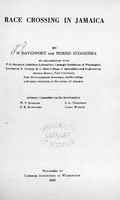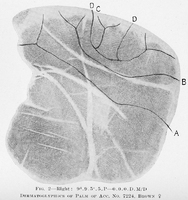Controlling Heredity
Charles Davenport's Race Crossing in Jamaica

Charles Benedict Davenport (American, 1866 – 1944)
Morris Steggerda (American, 1900 – 1950), et Alii
Race Crossing in Jamaica.
Washington, D.C.: Carnegie Institution, 1929.
Depository 572.97292 D27
University of Missouri Libraries
University of Missouri

Charles Benedict Davenport (American, 1866 – 1944)
Morris Steggerda (American, 1900 – 1950), et Alii
Race Crossing in Jamaica.
Washington, D.C.: Carnegie Institution, 1929.
Depository 572.97292 D27
University of Missouri Libraries
University of Missouri
Charles Davenport became director of Cold Spring Harbor Laboratory in 1910 and founded the Eugenics Record Office soon afterwards. He studied heredity and genetics early in his academic career, eventually devoting most of his time and effort to promoting, politicizing, and popularizing eugenics.
With the assistance of Mesoamerican anthropologist Morris Steggerda, Davenport attempted to quantify the consequences of "race crossing or miscegenation." In Race Crossing in Jamaica, the authors used a timed, block-arrangement exercise called the Knox Moron Test to test their subjects. The conclusions were not surprising: “The general impression made in this comparison of the three groups is that the Whites are relatively swift and accurate, the Blacks are slow but accurate, while the Browns are slow and inaccurate.” Other data presented in Race Crossing included palmar dermatoglyphics attempting to identify racial differences in the epidermis of the palm.
At the time of publication the work was roundly criticized for drawing conclusions which outstripped the data to the point of being counterfactual. Davenport’s racist interpretations of heredity were rejected by British and European eugenicists as unscientific and biased, helping brand American eugenics as racist and classist.